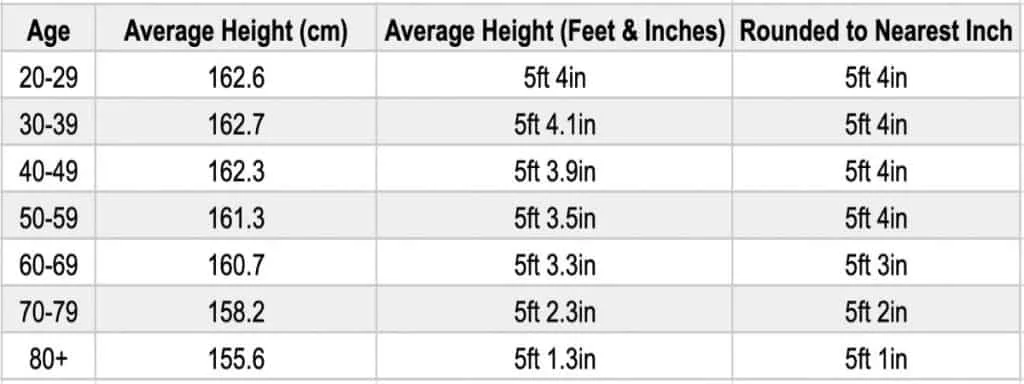Understanding Average Height for Women: Factors, Variations, and Importance
Height is a significant physical trait that varies across genders, ethnicities, and regions. For women, height is crucial to their overall appearance and confidence level. In the United States, the average height for women is around 5 feet 4 inches or 162.6 cm. However, this may vary based on several factors, like age, ethnicity, and geographical location.
Research shows that genetic factors mainly determine a person’s height. However, environmental factors like nutrition and physical activity can also impact growth and development. Moreover, understanding the average height for women can help people better understand their own physical traits and aid in choosing clothing sizes, furniture, and other items.
In this article, we will explore the average height for women in different countries and analyze the factors that affect height. So, let’s dive in and discuss more!
Factors Affecting the Height of Women
Genetics
The most crucial factor defining a person’s height is genetics. Height is a polygenic trait, which means several genes control it. Children inherit genes from their parents, and their height is often similar to theirs. For example, if both parents are tall, the child is more likely to be tall too.
Nutrition
Nutrition is another vital factor that affects height. Adequate nutrition is crucial for optimal growth and development, especially during childhood and adolescence. A diet rich in essential nutrients like protein, vitamins, and minerals can help promote healthy growth.
Physical Activity
Regular physical activity is also vital for optimal growth and development. Exercise helps stimulate growth hormone production, which is vital for growth. It also promotes the growth of strong bones and muscles, which can affect height.
Geographical Location
Height can vary based on geographical location due to several factors like climate, nutrition, and genetics. For example, people from Scandinavian countries are generally taller than those from Southeast Asia.
Average Height for Women in Different Countries
The average height for adult women varies across countries and ethnicities. In the United States, the average height for adult women is around 5 feet 4 inches or 162.6 cm. However, this varies based on several factors, like age, ethnicity, and geographical location.
In China, the average height for adult women is about 5 feet 2 inches or 157 cm. Moreover, in India, the average height for adult women is around 5 feet or 152.4 cm. In European countries like the Netherlands and Sweden, the average height for women is around 5 feet 7 inches or 170 cm.
Height Variations among Women
Height is a physical trait that can vary greatly among women. While the average height for women may be a baseline, it is crucial to recognize that people come in different shapes and sizes.
Genetics
One factor that can contribute to height variation among women is genetics. Genes can influence the growth and development of bones, muscles, and other tissues contributing to overall height. For example, some families may tend shorter or taller heights due to genetic factors.
Nutrition
Another factor that can affect height is nutrition. Sufficient nutrition is vital for proper growth and development during childhood and teenage, and malnutrition can result in stunted growth. Furthermore, some medical conditions or treatments can also affect height. For example, conditions that affect the endocrine system, like hypothyroidism, can lead to decreased height.
Environment
Environmental factors can also play a great role in height variation. For example, exposure to certain toxins or pollutants during development can decrease height. Additionally, cultural and socioeconomic factors can influence height, as people from certain regions or backgrounds may have different average heights.
In summary, height variation among women can be influenced by genetics, nutrition, medical conditions, and environmental factors. It is vital to recognize that people come in different shapes and sizes and to celebrate diversity by accommodating women of all heights and body types.
The Importance of Understanding Average Height for Women
Understanding the average height of an American woman is a crucial aspect of healthcare, clothing fitting, professional settings, and research. Following, we will discuss why it is crucial to understand the average height of women.
Health
Height can be an indicator of a person’s overall health, and deviations from the average height can be a sign of underlying health issues. For instance, if a teen girl’s height is quite below the average height for her age group, it may tell a growth hormone deficiency or malnutrition. Similarly, if an adult woman’s height decreases greatly from her previous height, it can be a sign of osteoporosis or other age-related conditions.
Clothing Fitting
Many clothing brands use height as a basis for sizing charts. Moreover, an understanding of the average height of women can help people find clothes that fit them well. It is crucial to note that not all women fit into the average height range, and clothing brands must offer various sizes to help women of different heights and body shapes.
Professional Settings
Some industries, like modeling, need specific height requirements, and knowing the average height can help people understand their eligibility for certain jobs. It can also be helpful for employers to understand the average height of women when designing uniforms or workspaces to make sure that they are suitable for all employees.
Research
Understanding the average American female height can be crucial for research purposes. Researchers may use average height data to study growth and development patterns or compare health outcomes across different populations.
Lastly, understanding the average height for women is crucial in many aspects of life. While it is crucial to recognize that height can vary widely among people, understanding the average height for women can be useful in healthcare, clothing fitting, skilled settings, and research. It is vital to promote inclusivity and diversity by adapting women of all heights and body shapes.
What is the average female height worldwide?
The average female height around the globe is around 5 feet 3 inches or 160 cm. However, significant variations exist across different regions and ethnicities. Some factors that affect height include genetics, nutrition, physical activity, and environmental factors. Environmental factors include climate and geography. Women from certain regions, like Scandinavia, tend to be taller than others.
What is the average height for women in the US?
The average height for women in US is around 5 feet 4 inches or 162.6 cm. However, this may vary based on several factors, like age, ethnicity, and geographical location. Height can also vary within a population due to genetics, nutrition, and physical activity.
What is the average height for girls in America?
The average height for girls in America varies based on their age. For girls between the ages of 2 and 19, the average height is around 4 feet 11 inches or 152 cm. However, this may vary based on several factors, like ethnicity, geographical location, and genetics. Girls usually face a growth spurt during puberty, which can result in a notable increase in height.
What is the average height for a teenage girl in the United States?
The average height for teen girls in the US varies based on their age. For girls between the ages of 13 and 19, the average height is around 5 feet 4 inches or 162.6 cm. However, this may vary based on several factors, like ethnicity, geographical location, and genetics. During the teen years, girls usually undergo a growth spurt, which can greatly increase height.
What are the height percentiles for American women?
Height percentiles for American women indicate how an individual woman’s height compares to the average height for women in the US. As per the Centers for Disease Control and Prevention (CDC), the 50th percentile height for adult women in the US is 5 feet 4 inches or 162.6 cm.
Women who are shorter or taller than this height fall below or above the 50th percentile, respectively. The CDC offers growth charts with height percentiles for girls and women of different ages.
What is the average height for American women of different races?

The average height for American women of different races varies slightly. As per the National Health and Nutrition Examination Survey (NHANES), the average height for non-Hispanic white women in the US is 5 feet 4 inches or 162.8 cm.

In contrast, the average height for non-Hispanic black women is 5 feet 3 inches or 160.6 cm. Mexican-American women have an average height of 5 feet 1.5 inches or 156.2 cm. These averages can vary based on several factors, like age, geographical location, and genetics.
What is the average Asian female height?
The average height for Asian females varies based on their ethnic group and geographical location. However, as per the World Health Organization (WHO), the average height for women in Asia is about 5 feet or 152 cm. This varies across different countries, with women in countries like South Korea and Japan tending to be shorter on average. In contrast, those in countries like China and India tend to be taller.
What is the average height for Hispanic women?
The average height for Hispanic women in the US varies based on their ethnic group. As per the National Health and Nutrition Examination Survey (NHANES), the average height for Mexican-American women is 5 feet 1.5 inches or 156.2 cm.
However, this may vary based on several factors, like age, geographical location, and genetics. Women from other Hispanic ethnic groups, like Puerto Rican or Cuban, may have different average heights.
What is the average Mexican female height?
The average height for Mexican females is about 5 feet 1.5 inches or 156.2 cm, as per the data from the National Health and Nutrition Examination Survey (NHANES). However, this may vary based on several factors, like age, geographical location, and genetics. Mexican females, like other Hispanic ethnic groups, may have different average heights based on their specific ethnic group. It is also critical to note that height can vary within a population due to individual differences.
What is the average height for black women?
The average height for black women in the US is around 5 feet 3 inches or 160.6 cm, as per the data from the National Health and Nutrition Examination Survey (NHANES). However, this may vary based on several factors, like age, geographical location, and genetics.
It is crucial to note that height can vary within a population due to people’s differences and that black women from different regions or countries may have different average heights.
What is the average height for white women?
The average height for white women in the US is around 5 feet 4 inches or 162.8 cm, as per the data from the National Health and Nutrition Examination Survey (NHANES). However, this may vary based on several factors, like age, geographical location, and genetics.
It is crucial to note that height can vary within a population due to individual differences and that white women from different regions or countries may have different average heights.
Importance of knowing the average height of a woman in the USA
Knowing the average height of a woman in the USA can be crucial for various reasons. It can deliver insight into potential health concerns and be useful in the medical field, as some conditions are linked to height. For example, shorter women may be more prone to osteoporosis or heart disease, while taller women may have a higher risk of developing cancer.
Furthermore, understanding the average height can help doctors to identify patients who may be at risk for certain conditions and offer the right preventive care.
Knowing the average height of women in the USA can also be important in the fashion industry. Clothing manufacturers use standard sizes that are based on average height and body measurements. Therefore, knowing the average height of women in the USA can help designers and manufacturers create clothing that fits the majority of women.
Furthermore, knowing the average height of women in the USA can be useful in the workplace. Some jobs may need people to meet certain height needs, like those in law enforcement or the military. Understanding the average height can help employers to set the right height conditions and avoid prejudice based on height.
Overall, while knowing the average height of a woman in the USA may not be crucial for everyday life, it can offer valuable information in various fields, including healthcare, fashion, and employment.
Sum Up
To sum up, understanding the average height for women is crucial in many aspects of life, including healthcare, clothing fitting, professional settings, and research. It serves as a valuable baseline and offers insight into potential health concerns or eligibility for certain jobs.
However, it is crucial to recognize that the average height does not represent the entire population and that people come in various shapes and sizes. We must celebrate and embrace diversity, promoting inclusivity by helping women of all heights and body types.
Furthermore, we must not allow height to define a person’s worth or abilities. It is crucial to focus on recognizing and valuing women for their unique qualities and contributions, regardless of their height. By doing so, we can create a more inclusive and accepting society that celebrates diversity and promotes equity for all.



